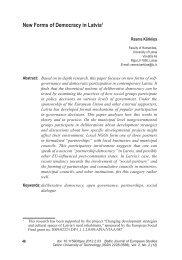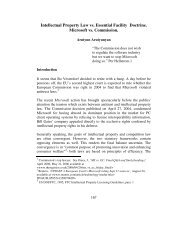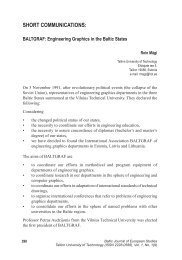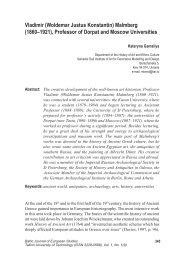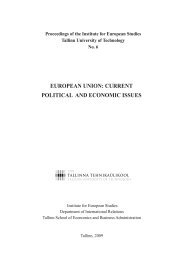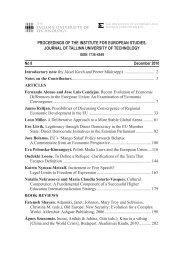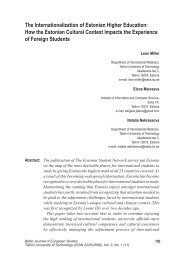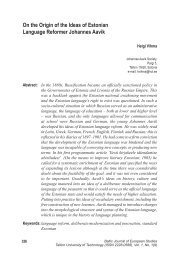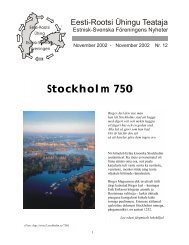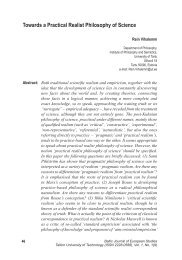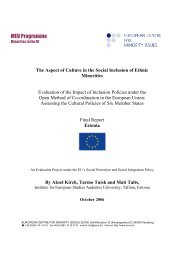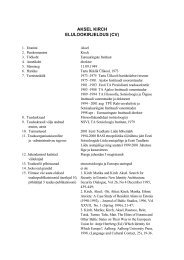Botanical Garden of the university of tartu (dorpat) - The Institute for ...
Botanical Garden of the university of tartu (dorpat) - The Institute for ...
Botanical Garden of the university of tartu (dorpat) - The Institute for ...
Create successful ePaper yourself
Turn your PDF publications into a flip-book with our unique Google optimized e-Paper software.
Heldur Sander, Toivo Meikar<br />
in 1832–1842 at <strong>the</strong> <strong>Botanical</strong> <strong>Garden</strong> <strong>of</strong> Göttingen and later at <strong>the</strong> botanical<br />
gardens <strong>of</strong> Bonn and Berlin. Since 1842, Regel was <strong>the</strong> head <strong>of</strong> <strong>the</strong> <strong>Botanical</strong><br />
<strong>Garden</strong> <strong>of</strong> Zürich and lectured at <strong>the</strong> Zürich University. In 1855–1892, he headed<br />
<strong>the</strong> <strong>Botanical</strong> <strong>Garden</strong> <strong>of</strong> St Petersburg.<br />
Italian botanist Michele Tenore (1780–1861) sent 508 accessions in 1840. He<br />
worked in Naples, Italy. In 1810, he was nominated director <strong>of</strong> <strong>the</strong> <strong>Botanical</strong><br />
<strong>Garden</strong> <strong>of</strong> Naples (established in 1807).<br />
Botanist Roberto de Visiani (1800–1878) from <strong>the</strong> Botanic <strong>Garden</strong> <strong>of</strong> Padua<br />
sent 195 accessions. Visiani graduated from <strong>the</strong> medical faculty <strong>of</strong> <strong>the</strong> University<br />
<strong>of</strong> Padua in 1822 and became an assistant <strong>of</strong> Giuseppe Antonio Bonato (1753–<br />
1836). After Bonato’s death, he became his successor as <strong>the</strong> head <strong>of</strong> <strong>the</strong> Chair <strong>of</strong><br />
Botany and <strong>the</strong> director <strong>of</strong> <strong>the</strong> <strong>Botanical</strong> <strong>Garden</strong> <strong>of</strong> Padua since 1837.<br />
58 accessions were sent from Bologna by Bertoloni. <strong>The</strong> sender could have<br />
been ei<strong>the</strong>r Antonio Bertoloni (1775–1869), famous botanist and compiler<br />
<strong>of</strong> <strong>the</strong> 10-volume Flora <strong>of</strong> Italy, or his son Giuseppe Bertoloni (1804–1878),<br />
pr<strong>of</strong>essor <strong>of</strong> botany at <strong>the</strong> University <strong>of</strong> Bologna. Plants or seeds were sent from<br />
Italy also by Bartolomeo Biasoletto (1793–1858), pharmacist and botanist<br />
from Trieste, and by Carlo Donarelli (1797–1851), physician, pr<strong>of</strong>essor <strong>of</strong><br />
practical botany and director <strong>of</strong> <strong>the</strong> <strong>Botanical</strong> <strong>Garden</strong> <strong>of</strong> Rome at <strong>the</strong> University<br />
La Sapienza from 1833 to 1851.<br />
Contributors <strong>of</strong> rare plants from exotic locations<br />
Plants were sent from Mexico by Christian Julius Wilhelm Schiede (1798–<br />
1836), a German physician and botanist born in Kessel. He studied natural<br />
sciences and medicine at <strong>the</strong> universities <strong>of</strong> Berlin and Göttingen, where he<br />
earned his doctorate in 1825. <strong>The</strong>reafter, he worked as a practicing physician in<br />
Kessel. In 1828, he emigrated to Mexico, where he accompanied <strong>the</strong> naturalist<br />
Ferdinand Deppe (1794–1861) on his expeditions. <strong>The</strong> two explorers collected<br />
zoological and botanical specimens <strong>for</strong> various museums, universities and<br />
botanical gardens <strong>of</strong> Europe. In <strong>the</strong> summer <strong>of</strong> 1828, Schiede and Deppe settled<br />
in Jalapa and organised research expeditions throughout <strong>the</strong> state <strong>of</strong> Veracruz.<br />
Schiede sent 97 accessions in 1829 from Jalapa, Laguna, Pico de Orizaba and<br />
Cali<strong>for</strong>nia.<br />
Thirty accessions were sent from Guatemala in 1852 by Jegor Julius von Sivers<br />
(1824–1879), descendant <strong>of</strong> <strong>the</strong> Sivers family <strong>of</strong> Õisu (Euseküll) Manor, born in<br />
Heimtali (Heimthal) Manor (Estonia) in <strong>the</strong> family <strong>of</strong> Peter Reinhold Sivers. He<br />
246<br />
Baltic Journal <strong>of</strong> European Studies<br />
Tallinn University <strong>of</strong> Technology (ISSN 2228-0588), Vol. 1, No. 1(9)



